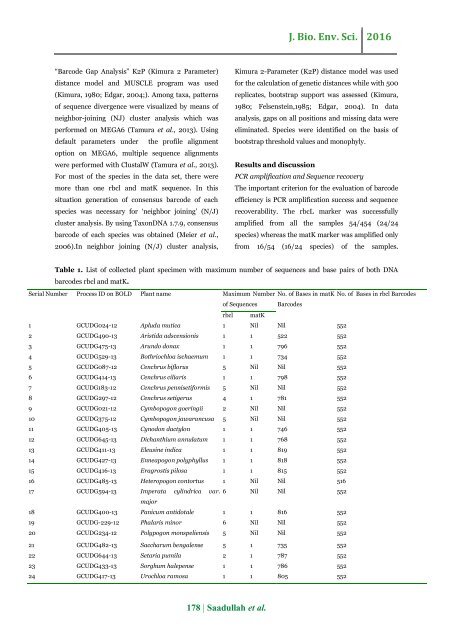Identification of the grass family (Poaceae) by using the plant dna barcodes rbcl and matK
Abstract Due to phenotypic plasticity, with few distinguishable and many overlapping characters, grasses are very difficult to identify by morphological characters, The current research evaluated how standard plant barcode rbcl and matK can help in floristic evaluation of. grasses belonging to a not well studied flora in district Dera Ghazi Khan, Punjab, Pakistan. In this study, 54 specimen belonging to 24 species of Poaceae were examined. Species wise sequencing success for rbcl and matK was 100% and 66.67% respectively. The determination of intra and inter-specific divergence and phylogentic analysis by reconstruction of neighbor joining trees were carried out. The results demonstrated that individually both rbcl and matK totally failed in discrimination of congeneric species. In neighbor joining phylogenetic analysis both rbcl and matK provided well resolved monophyletic tree with weak bootstrap threshold value. While in combination (rbcl+matK) both marker provided well resolved monophyletic tree with strong bootstrap threshold value.
Abstract
Due to phenotypic plasticity, with few distinguishable and many overlapping characters, grasses are very difficult to identify by morphological characters, The current research evaluated how standard plant barcode rbcl and matK can help in floristic evaluation of. grasses belonging to a not well studied flora in district Dera Ghazi Khan, Punjab, Pakistan. In this study, 54 specimen belonging to 24 species of Poaceae were examined. Species wise sequencing success for rbcl and matK was 100% and 66.67% respectively. The determination of intra and inter-specific divergence and phylogentic analysis by reconstruction of neighbor joining trees were carried out. The results demonstrated that individually both rbcl and matK totally failed in discrimination of congeneric species. In neighbor joining phylogenetic analysis both rbcl and matK provided well resolved monophyletic tree with weak bootstrap threshold value. While in combination (rbcl+matK) both marker provided well resolved monophyletic tree with strong bootstrap threshold value.
You also want an ePaper? Increase the reach of your titles
YUMPU automatically turns print PDFs into web optimized ePapers that Google loves.
J. Bio. Env. Sci. 2016<br />
“Barcode Gap Analysis” K2P (Kimura 2 Parameter)<br />
distance model <strong>and</strong> MUSCLE program was used<br />
(Kimura, 1980; Edgar, 2004;). Among taxa, patterns<br />
<strong>of</strong> sequence divergence were visualized <strong>by</strong> means <strong>of</strong><br />
neighbor-joining (NJ) cluster analysis which was<br />
performed on MEGA6 (Tamura et al., 2013). Using<br />
default parameters under <strong>the</strong> pr<strong>of</strong>ile alignment<br />
option on MEGA6, multiple sequence alignments<br />
were performed with ClustalW (Tamura et al., 2013).<br />
For most <strong>of</strong> <strong>the</strong> species in <strong>the</strong> data set, <strong>the</strong>re were<br />
more than one <strong>rbcl</strong> <strong>and</strong> <strong>matK</strong> sequence. In this<br />
situation generation <strong>of</strong> consensus barcode <strong>of</strong> each<br />
species was necessary for ‘neighbor joining’ (N/J)<br />
cluster analysis. By <strong>using</strong> TaxonDNA 1.7.9, consensus<br />
barcode <strong>of</strong> each species was obtained (Meier et al.,<br />
2006).In neighbor joining (N/J) cluster analysis,<br />
Kimura 2-Parameter (K2P) distance model was used<br />
for <strong>the</strong> calculation <strong>of</strong> genetic distances while with 500<br />
replicates, bootstrap support was assessed (Kimura,<br />
1980; Felsenstein,1985; Edgar, 2004). In data<br />
analysis, gaps on all positions <strong>and</strong> missing data were<br />
eliminated. Species were identified on <strong>the</strong> basis <strong>of</strong><br />
bootstrap threshold values <strong>and</strong> monophyly.<br />
Results <strong>and</strong> discussion<br />
PCR amplification <strong>and</strong> Sequence recovery<br />
The important criterion for <strong>the</strong> evaluation <strong>of</strong> barcode<br />
efficiency is PCR amplification success <strong>and</strong> sequence<br />
recoverability. The rbcL marker was successfully<br />
amplified from all <strong>the</strong> samples 54/454 (24/24<br />
species) whereas <strong>the</strong> <strong>matK</strong> marker was amplified only<br />
from 16/54 (16/24 species) <strong>of</strong> <strong>the</strong> samples.<br />
Table 1. List <strong>of</strong> collected <strong>plant</strong> specimen with maximum number <strong>of</strong> sequences <strong>and</strong> base pairs <strong>of</strong> both DNA<br />
<strong>barcodes</strong> <strong>rbcl</strong> <strong>and</strong> <strong>matK</strong>.<br />
Serial Number Process ID on BOLD Plant name Maximum Number No. <strong>of</strong> Bases in <strong>matK</strong> No. <strong>of</strong> Bases in <strong>rbcl</strong> Barcodes<br />
<strong>of</strong> Sequences Barcodes<br />
<strong>rbcl</strong> <strong>matK</strong><br />
1 GCUDG024-12 Apluda mutica 1 Nil Nil 552<br />
2 GCUDG490-13 Aristida adscensionis 1 1 522 552<br />
3 GCUDG475-13 Arundo donax 1 1 796 552<br />
4 GCUDG529-13 Bothriochloa ischaemum 1 1 734 552<br />
5 GCUDG087-12 Cenchrus biflorus 5 Nil Nil 552<br />
6 GCUDG414-13 Cenchrus ciliaris 1 1 798 552<br />
7 GCUDG183-12 Cenchrus pennisetiformis 5 Nil Nil 552<br />
8 GCUDG297-12 Cenchrus setigerus 4 1 781 552<br />
9 GCUDG021-12 Cymbopogon goeringii 2 Nil Nil 552<br />
10 GCUDG375-12 Cymbopogon jawarancusa 5 Nil Nil 552<br />
11 GCUDG405-13 Cynodon dactylon 1 1 746 552<br />
12 GCUDG645-13 Dichanthium annulatum 1 1 768 552<br />
13 GCUDG411-13 Eleusine indica 1 1 819 552<br />
14 GCUDG427-13 Enneapogon polyphyllus 1 1 818 552<br />
15 GCUDG416-13 Eragrostis pilosa 1 1 815 552<br />
16 GCUDG485-13 Heteropogon contortus 1 Nil Nil 516<br />
17 GCUDG594-13 Imperata cylindrica var. 6 Nil Nil 552<br />
major<br />
18 GCUDG400-13 Panicum antidotale 1 1 816 552<br />
19 GCUDG-229-12 Phalaris minor 6 Nil Nil 552<br />
20 GCUDG234-12 Polypogon monspeliensis 5 Nil Nil 552<br />
21 GCUDG482-13 Saccharum bengalense 5 1 735 552<br />
22 GCUDG644-13 Setaria pumila 2 1 787 552<br />
23 GCUDG433-13 Sorghum halepense 1 1 786 552<br />
24 GCUDG417-13 Urochloa ramosa 1 1 805 552<br />
178 | Saadullah et al.





![Review on: impact of seed rates and method of sowing on yield and yield related traits of Teff [Eragrostis teff (Zucc.) Trotter] | IJAAR @yumpu](https://documents.yumpu.com/000/066/025/853/c0a2f1eefa2ed71422e741fbc2b37a5fd6200cb1/6b7767675149533469736965546e4c6a4e57325054773d3d/4f6e6531383245617a537a49397878747846574858513d3d.jpg?AWSAccessKeyId=AKIAICNEWSPSEKTJ5M3Q&Expires=1715292000&Signature=dDjCIoI03z2bEWiDGXg8GWFwESI%3D)












